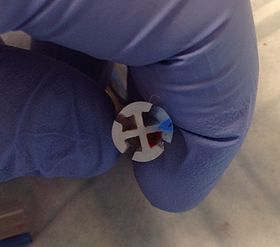| Chest tube | |
|---|---|
 The free end of the chest drainage device is usually attached to an underwater seal, below the level of the chest. This allows the air or fluid to escape from the pleural space and prevents anything returning to the chest. | |
| Other names | Intercostal drain |
| Specialty | Pulmonology |
| ICD-9-CM | 34.04 |
| MeSH | D013907 |
A chest tube (also chest drain, thoracic catheter, tube thoracostomy or intercostal drain) is a surgical drain that is inserted through the chest wall and into the pleural space or the mediastinum. The insertion of the tube is sometimes a lifesaving procedure. The tube can be used to remove clinically undesired substances such as air (pneumothorax),[1] excess fluid (pleural effusion or hydrothorax), blood (hemothorax), chyle (chylothorax) or pus (empyema) from the intrathoracic space. An intrapleural chest tube is also known as a Bülau drain or an intercostal catheter (ICC), and can either be a thin, flexible silicone tube (known as a "pigtail" drain), or a larger, semi-rigid, fenestrated plastic tube, which often involves a flutter valve or underwater seal.
The concept of chest drainage was first advocated by Hippocrates when he described the treatment of empyema by means of incision, cautery and insertion of metal tubes.[2] However, the technique was not widely used until the influenza epidemic of 1918 to evacuate post-pneumonic empyema, which was first documented by Dr. C. Pope, on a 22-month-old infant.[3] The use of chest tubes in postoperative thoracic care was reported in 1922,[4] and they were regularly used post-thoracotomy in World War II, though they were not routinely used for emergency tube thoracostomy following acute trauma until the Korean War.[5]
- ^ Noppen M, Alexander P, Driesen P, Slabbynck H, Verstraeten A (May 2002). "Manual aspiration versus chest tube drainage in first episodes of primary spontaneous pneumothorax: a multicenter, prospective, randomized pilot study". American Journal of Respiratory and Critical Care Medicine. 165 (9): 1240–1244. doi:10.1164/rccm.200111-078OC. PMID 11991872.
- ^ Hippocrates (1847). Genuine Works of Hippocrates. Sydenham Society.
- ^ Graham ME, Bell CR (1918). "Open Pneumothorax: Its relation to the treatment of empyema". J Med Sci. 156 (6): 839–871. doi:10.1097/00000441-191812000-00007.
- ^ Lilienthal H (March 1922). "Resection of the lung for supportive infections with a report based on 31 consecutive operative cases in which resection was done or intended". Annals of Surgery. 75 (3): 257–320. doi:10.1097/00000658-192203000-00001. PMC 1399898. PMID 17864604.
- ^ Miller KS, Sahn SA (February 1987). "Chest tubes. Indications, technique, management and complications". Chest. 91 (2): 258–264. doi:10.1378/chest.91.2.258. PMID 3542404.